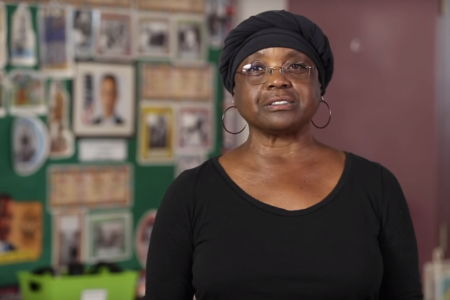Share On Social!
Linda Joseph, a special needs teacher in Florida, with some of the highest drowning rates in the country, wanted to make sure her students could swim and weren’t afraid of the water. As someone who values whole-child health, Joseph knows that water safety boosts confidence and opens doors to many water-based physical activities and associated mental and physical benefits. She went to a nearby pool for information and learned about and enrolled her students in free water safety education lessons through SWIM Central.
Fear of Drowning is High in Florida

Linda Joseph, a special needs teacher at Lauderdale Lakes Middle School, in Fort Lauderdale, Fla. (13.7% Latino), lost both of her parents to a drowning accident when she was 16.
She became fearful of water and didn’t learn to swim until she was 30.
“I lived with that fear for many, many years,” Joseph said.
Swimming is a popular, year-round activity in Florida because of its close proximity to water and its temperate climates, but this also has led to its consistently high drowning rates. In fact, childhood drowning rates are higher in Florida than any other state. In the late 1990s, more than 20 kids were drowning each year in Fort Lauderdale’s home county, Broward (27.5% Latino).
Joseph wanted her students to learn water safety to lessen their risk of drowning, reduce their fear, and open a world of life-enriching water activities.
“When I learned how to swim, there were so many fears I had in me that disappeared,” Joseph said. “That was part of my drive to get the kids to learn to swim. My confidence level went through the roof when I absolved myself of that fear.”
Joseph also noticed weight-related health concerns in her students that were previously only seen adults, like diabetes and heart disease.
“In my students, we are dealing with weight issues, due to the medications they take,” Joseph said.
Although most parents expect their children to engage in water activity, about 61% reported that their children cannot demonstrate five basic skills that can save their lives in the water, according to an American Red Cross survey.
Drowning and related injuries disproportionately burden Latinos and African Americans.

Source: Google Earth
Children with disabilities (12.1% of the nation’s students) tend to be even more fearful of the water.
Drowning is, for example, the leading cause of death for people with autism.
One of Lauderdale Lakes’ special needs students almost drowned when he jumped into a canal.
“One of our parents almost lost their son because he didn’t know how to swim,” Joseph said. “He isn’t cognitively aware that he should have a fear.”
Even though he didn’t have fear, his parents did.
Water safety education is important for drowning prevention, but it also increases children’s opportunities for physical activity and much more.
“It is sensory, it is developmental, it is social, and it is individual,” said Ingrid Garcia of the Broward Children’s Center, which provides school programming for infants, children, and young adults with disabilities. “It is definitely very sensory to have kids put their heads under the water. These children are socializing with and trusting [trained water safety] instructors and overcoming personal fears and barriers.”

Source: DROWNING PREVENTION: Community Education Outreach Training Handbook
Joseph wanted to help reduce fear of water for everyone, but how?
Broward County Starts Voluntary SWIM Central Program
Long before Joseph had a desire to start a healthy change in her school, an organization would emerge that eventually would aid her quest.
In 1997, due to drastic drowning rates in Broward County, an ad-hoc committee, Safe Water Instruction Means Safety Foundation (SWIMS Foundation), developed a drowning prevention coalition.
It began with a phone call from a Miami Herald investigative reporter, Ron Ishoy, to the director of the International Swimming Hall of Fame, Sam Freas, which set off a chain of events involving local leaders such as, Diana Wasserman-Rubin, school board member involved in bring the American Red Cross Whale Tales program to county schools, Kim Burgess, assistant director of the International Swimming Hall of Fame, Ilene, Lieberman, Broward County Commissioner, and Mike Harlan, assistant director of the Broward County Parks and Recreation, according to Bob Harbin’s History of Broward County’s SWIM Central Program.
The coalition discovered that swim lessons and resources were not easily accessible, thus parents didn’t know where to go for water safety education.
The coalition wanted to (1) raise awareness of drowning prevention, (2) provide a hub for information and resources, and (3) teach kindergarteners how to swim, so they began community outreach through brochures, flyers, TV commercials, and a drowning prevention hotline, and sought funding.

Source: Children’s Services Council of Broward County 2014-2015 Annual Report
In 1999, SWIM Central formed after the coalition got $82,000 from the Broward County Commission. Later that year, State Representative Debbie Wasserman Schultz obtained $200,000 from the state through the School Board.
SWIM Central began reaching out to schools that offered free and reduced lunches and were located near pools. In the first year they got 24 schools to participate and spent $301,000 in just lessons. The Children’s Services Council (CSC), which funds programs and services to enhance children’s lives in Broward County, has since become the primary funder of SWIM Central, providing over $600,000 in the 2014-2015 fiscal year, along with Broward County and Broward County School District.
In 2015, over 200 Broward schools participated in SWIM Central; however, some schools did not.
The school board has not mandated that schools participate in the water safety education program, but SWIM Central has ensured it is accessible to all public schools.
SWIM Central makes it easy for schools to participate. They provide a package of materials—in five different languages—for schools to send to parents. They also help with locating and scheduling a pool.
“When a new school signs up, a SWIM Central coordinator calls to schedule lessons,” Jay Sanford, the manager of SWIM Central said. “We identify a local pool, which might be a municipal park and recreation swimming facility, a YMCA facility, or another school facility.”
SWIM Central uses partnerships within the drowning prevention coalition, such as the state department of health, and the Broward fire, sheriffs, and police departments to help influence hesitant schools to participate.

Source: Broard County Parks and Recreation
“When a school decides not to do program, we slip their name to fire chief and he will go and make an impassioned plea to the school,” Sanford said. “And often times, those schools come back.”
Special Needs Teacher Asks Parents to Participate
SWIM Central had been operating for almost seven years when Joseph learned about it.
She took her students on daily walks around the school campus when she noticed the swimming pool next door one day. Every day after that, she kept looking at the pool wondering if there was some way her kids could use the pool.
So she decided to walk over to the pool and ask the staff how she could get her special needs students in the pool and they referred her to SWIM Central
SWIM Central provides 10, 30-minute water safety education classes over a two-week period, at no cost to the parent. The curriculum-based program is taught by certified water safety instructors at various facilities across the county. Facilities get reimbursed at a rate of $32 per student for use of their pools and staff, resulting in year-round revenue-generating swim programs.
SWIM Central sent Joseph a request form.

Source: Water Smart Broward
“It was very easy,” Joseph said referring to the SWIM Central website. “I just indicated that our school was next door to the pool and I would like to get my students swimming in the pool.”
SWIM Central then gave her a package of materials she would need to obtain approval from the principal and from the parents. The packages came in five different languages and explained the curriculum-based program.
Joseph sent the materials to her students’ parents.
All of the parents agreed and returned the signed permission forms.
In 2008, with parents and the principal’s approval, Joseph scheduled her sixth-grade special needs class to participate in SWIM Central at the neighboring Lauderdale Lakes pool.
Students with special Needs Learn Water Safety
In fall 2008, Joseph walked her sixth-grade special needs class to the pool to start free water safety education classes, where the instructors have been very accommodating for students with special needs, Joseph said.
“The lifeguard gives them water therapy to soothe the students, help them get over their fear, and to just let them relax and get used to how the water feels,” she said.
After Joseph took her special needs students, she wanted to take all the schools’ sixth-graders. She talked with the principal and worked with SWIM Central and Lauderdale Lakes Swimming Pool to schedule it.
SWIM Central water safety education classes are free to schools, teachers, and parents.
In addition to water safety education classes, SWIM Central funding also provides transportation for students attending schools not in walking distance to a pool.

Source: Children’s Services Council of Broward County Florida Facebook
Although participation in SWIM Central is not mandated by the school district, it is easily accessible and free. It has been operating for 15 years and has developed strong partnerships and agreements with public and private facilities.
Additionally, residents of Broward recognize that drowning rates among school-age children in Broward County have almost been eliminated.
In addition to reducing the risk of drowning, Joseph is proud she helps her students overcome fear of water and opens the door the numerous other physical activities in the water.
“Physical activity is connected with our health,” Joseph said. “Exercise is the reason we are sickly or well. Wellness isn’t just physical, it is also mental.”
By The Numbers
84
percent
of Latino parents support public funding for afterschool programs
This success story was produced by Salud America! with support from the Robert Wood Johnson Foundation.
The stories are intended for educational and informative purposes. References to specific policymakers, individuals, schools, policies, or companies have been included solely to advance these purposes and do not constitute an endorsement, sponsorship, or recommendation. Stories are based on and told by real community members and are the opinions and views of the individuals whose stories are told. Organization and activities described were not supported by Salud America! or the Robert Wood Johnson Foundation and do not necessarily represent the views of Salud America! or the Robert Wood Johnson Foundation.



